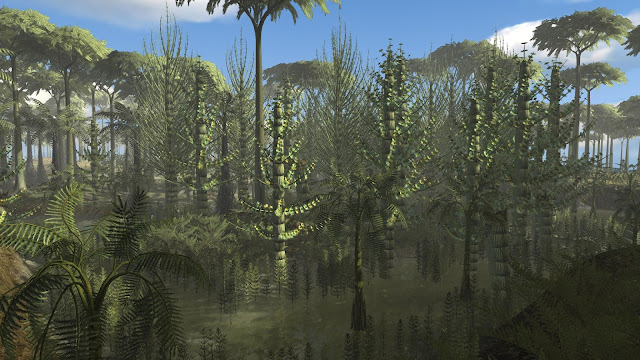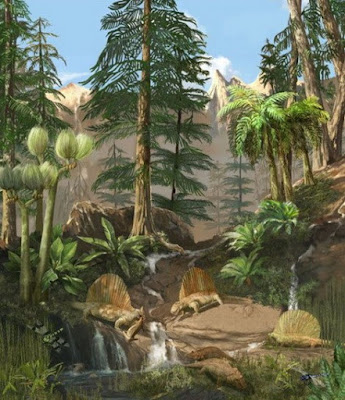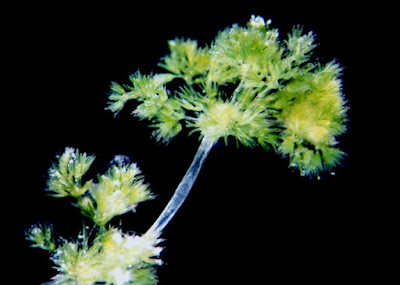Pterophytes, the not so 'Pterofying' tale of ferns and horsetails.
The marshy forests of the Carboniferous period, 295 million
years ago, were not only filled with tall, Lycophytes, they were also abundant
with Pterophytes, such as ferns, and horsetails (Reece & Campbell 2012).
Within this phylum, and perhaps the most familiar to us, is the fern,
Filicopsida.
 |
| Artist impression of Carboniferous forest. |
Today there are approximately 12,000 extant species of ferns
distributed worldwide, that make up the largest, most diverse group of all
vascular plants (Pearson 1995). Most species of fern favour moist, shaded tropical
climates, are herbaceous, and have large macrophylls called fronds. Fern
sporophyte extend themselves through the tip of an underground perennial stem,
called a rhizome (Rost 1998). From this horizontally branched dichotomous stem,
adventitious roots radiate underground, whilst fronds arise vertically from the
rhizome. Young fern fronds are coiled tightly and aptly named fiddleheads, as
they resemble the head stock of a fiddle (Pearson 1995). This coiled formation
protects their meristematic tissue as the coiled frond thrusts its way up
through the soil. Once above the soil, the frond unfurls in an upward motion
from the base (Rost 1998). Most fern species are also homosporus, with clustered
sporangia called sori located on the underside of the fronds on the sporophyte.
When released, spores are catapulted some distance away and transported via
anemechory (Reece & Campbell 2012).
 |
| Life cycle of Filicopsida. |
Within the Sphenophyta phylum, there are currently only 15
species, all within a single genus, Equisetum
(Rost 1998). Much like ferns, horsetails also have a horizontal perennial
rhizome from which aerial stems vertically arise. They also are homosporous,
producing bisexual gametophytes from spores (Willis & McElwain 2014). There
are, however, many features unique to horsetails. One of the most unique
features is the abrasive texture of the stem. The stem epidermis contains
silica, and during the pioneering era, was used to scour and clean pots and
pans. Hence one of the many common names acquired is ‘scouring rush’ (Rost
1998).Other distinctive morphological features are whorled microphyllous
leaves and branches, which alternate with each other at each segmented joint,
instead of branching from buds in the axils of the leaves like other vascular
plants. The stems are also hollow and are arranged into jointed segments,
giving the rise to another common name, Arthrophytes (Willis & McElwain 2014).
 |
| Horsetail diagram and stem cross section. |
References:
Pearson, L.C. 1995, The
diversity and evolution of plants, CRC Press, Boca Raton.
Reece, J.B. & Campbell, N.A. 2012, Campbell biology, 9th (Australian version) edn, Pearson Australia,
Frenchs Forest, N.S.W.
Rost, T.L. 1998, Plant
biology, Wadsworth, Belmont, Calif.
Willis, K.J. & McElwain, J.C. 2014, The evolution of plants, Second edn, Oxford University Press,
Oxford.
Unknown Author 2012, Fern
lifecycle, image, viewed April 2018, < http://creating-a-new-earth.blogspot.com.au/2012/06/networkers-nature-art.html>.
Paolo 2014, Carboniferous forest, image, viewed April 2018,< http://www.thefossilforum.com/index.php?/topic/46827-real-time-simulation-of-a-carboniferous-forest-wip/&page=3 >.
Navi.info 2017, Equisetum
diagram, image, viewed April 2018, < https://tabi-navi.info/imalhdrm-horsetail-labeled.html>.
https://www.youtube.com/watch?v=z33aCPuTmTQ
Robert Klips 2012, Equisetum hyemale releases spores [Online video] viewed April 2018.



Ferns and horsetails are pretty awesome. I thought that the angiosperms (flowering plants) were the most diverse group of vascular plants? Do you mean that the ferns are the most diverse in the group known as the Pterophytes and Lycophytes?
ReplyDelete